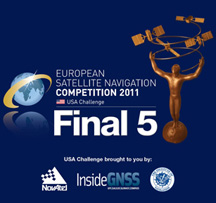
The following is one of the five top submissions to the 2011 USA Challenge. The North American regional contest in the European Satellite Navigation Competition(ESNC) is a global search for the newest, best and most innovative GNSS application ideas with €20,000 in prize money for the international winner, the 2011 Galileo Master.
SMPTE/GNSS
The following is one of the five top submissions to the 2011 USA Challenge. The North American regional contest in the European Satellite Navigation Competition(ESNC) is a global search for the newest, best and most innovative GNSS application ideas with €20,000 in prize money for the international winner, the 2011 Galileo Master.
SMPTE/GNSS
GNSS data comes out as NMEA or proprietary binary data, typically as a UART or other serial stream.
So, the challenge is, how do you put UART data into digital video? Define a new subtype in the container? For MPEG and WebM? Rewrite the codecs on both ends to include it? How do you send UART data over common mediums like cell phone audio? Old FSK modems? What about >1Hz
SMS is really low bandwidth and high latency. Data communications can be difficult or expensive, and coverage is an issue. UART data doesn’t work well for really cheap RF equipment.
However, SMPTE linear time code (LTC) has been around for decades. It has been used with MIDI sequencers by encoding a track, and then, when it is played back, you know the precise time.
SMPTE LTC has fields for Hours, Minutes, Seconds, and Frames. There are variants for film, TV (US, European), and 30fps video, each picture has a frame. It also has space for 8 user defined (4bit) digits per frame.
So, a simple solution is to merge the GNSS data into the user bytes of the SMPTE LTC stream. For 30fps, there are six frames for a 5Hz GNSS stream. That is room enough for 48 digits; so, with some smart packing (e.g., N/S, E/W, Longitude >= 100 as bits within a digit), most if not all of the data, including fix quality and year/month/date, can be inserted into the stream.
The standard SMPTE HH:MM:SS:FF would come directly from the GNSS UTC time, and if high precision is desired, the first bit of frame zero can be synchronized with a PPS output using a PLL technique. This can be done with existing inexpensive microcontrollers, or built into advanced GNSS chips by adding or replacing the UART with variable pulse width output.
Applications: Most video allows for extra audio tracks, e.g., other languages, director’s comments, etc., but even simple recorders typically have stereo. Use one track for SMPTE/GNSS and your video now has contemporaneous location as well as velocity information.
The bandwidth is under 5kHz but the audio codec used might create an issue. However, most audio that can carry voice and music with adequate fidelity should work, or the frequency could be altered or stream-transcoded to fit within cell phone audio limitations.
Simple RF transmitters can handle the low-bandwidth pulse stream waveform since it is continuous.
WHO DID IT?
Thomas Zerucha, Z Designs
Toledo, Ohio USA
FOR MORE INFO
http://zdez.com/smptegps/
thomas@mich.com
Learn about the other finalists:



